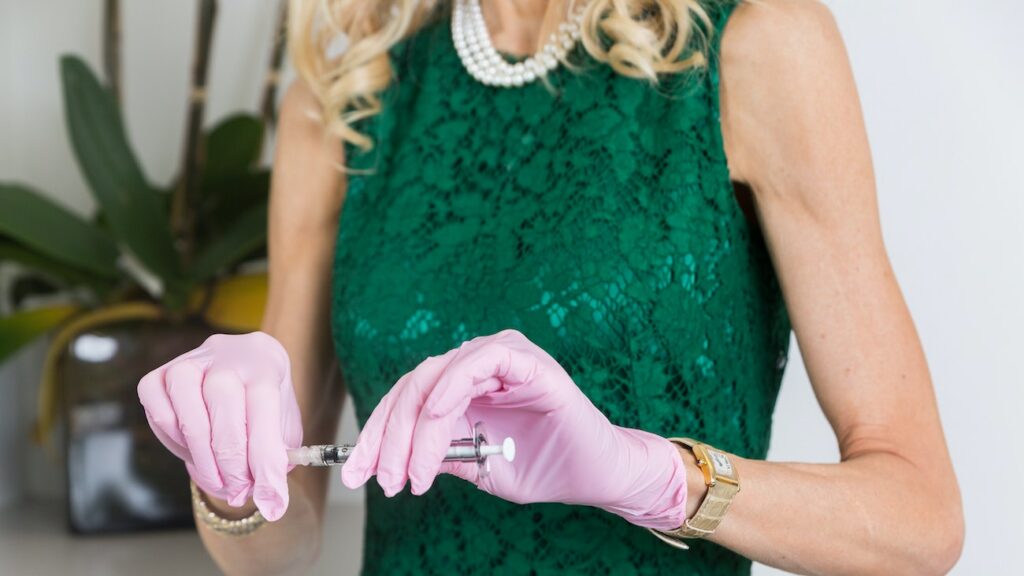Experts Reveal 8 Filler Mistakes All First-Time Patients Need to Avoid
Thespotlyte | July 27, 23

As passionate as we are about hyaluronic acid-based moisturizers, no jar of cream on any shelf (and no amount of slathering it on) can ever restore the lost volume of an injectable filler. During this treatment, a professional (usually a plastic surgeon or dermatologist) injects hyaluronic acid directly into the face to temporarily add plump fullness to areas like cheeks and lips. But if you’ve been considering it a go, it’s essential that you first do your homework — and your work doesn’t stop with finding the right licensed provider. Keep reading to discover what top plastic surgeons say you absolutely shouldn’t do before and after your treatment.
[Editor’s note: Injectable filler is a temporary treatment that adds volume to areas of the face such as the lips, cheeks, and laugh lines. Like any medical treatment, it has potential risks and side effects. Be sure to talk to a licensed provider to see if it’s right for you. Have more questions? Chat with our team of trained aesthetic specialists now.]

STOCKSY UNITED / VICTOR TORRES
Choosing the Wrong Provider
We’ve said it before and we’ll say it again — do your research when it comes to selecting your licensed provider. Columbus-based board-certified plastic surgeon Dr. Robert Heck shares that now more than ever, there are many inexperienced injectors putting in filler. “Sometimes they don’t take the time to know exactly what somebody’s looking for,�? he says. Look for a board-certified provider who focuses on getting to know what you expect from your treatment. Looking for an aesthetic provider? Our trained specialists can help!

Focusing on One Area
Fort Worth-based board-certified plastic surgeon Dr. Steven Camp blames the “selfie revolution�? for skewing how some patients see themselves as well as manipulating their treatment. “The consultation process is so essential,�? he explains. “A lot of times the perceived images — which are strained from holding a camera at an angle or flexing and turning the head and looking at the mirror at an angle — don’t really reflect the way that we appear to other people in real life.�? Check your selfie before you wreck your selfie: you’ll get the best results by being less self-critical and working with your licensed provider to analyze the face as a whole before deciding where to add filler (and how much).
Columbus-based board-certified plastic surgeon Dr. Jeffrey Donaldson agrees, calling it a “discovery process.�? Creating a relationship with your licensed provider will help him or her determine how filler might best accomplish your goals.

STOCKSY UNITED / MICHELA RAVASIO
Taking Certain Medications and Supplements . . . or Drinking Red Wine
Dr. Donaldson warns his patients not to ingest anything that could increase the risk of bruising, which ranges from aspirin and vitamin E to red wine (!). But while he suggests skipping the former for about a week pre-procedure, don’t worry — you can indulge in your vino until the day before, as it doesn’t thin the blood as powerfully as aspirin.
[Editor’s note: Please consult your physician before stopping any medication.]

Not Listening to Your Licensed Provider’s Dosage Recommendation
Some patients might be looking to save money, while others are wary of looking too “done,�? but both could fall prey to the same filler mistake: underdosing. “People will say, ‘I don’t want to dive off the deep end right away,’�? said board-certified plastic surgeon Dr. Stephan Finical, who is based in Charlotte. “But if they stay with one syringe when they need two, then they don’t get the full effect.�?
Alternatively, some patients might demand dramatically voluminous results, which could end up looking unnatural or less than aesthetically pleasing. Whether you end up with too little filler or too much, the result is the same: frustration and dissatisfaction. Let your licensed provider guide the treatment and decide how much filler you should get.

STOCKSY UNITED / MICHELA RAVASIO
Not Bringing In Inspiration Photographs
Think of it like going to a new colorist for the first time: it helps immensely to bring the expert photos of the result you’d like. If the result you want is “me, but 10 years ago,�? then by all means, bring in a photo of yourself from that time frame!
“It’s particularly helpful in comprehensive facial rejuvenation patients to see images from their past, to sort of know where their most youthful bone structure and skin properties started as a baseline,�? says Dr. Donaldson. “Then we can help them achieve some return to that look.�?

Sleeping on Your Side
You can expect some swelling after your filler treatment, and the way you sleep that night could exacerbate it. “We encourage patients maybe to sleep with their head slightly elevated that night, not to sleep on their side for 24 to 48 hours,�? Dr. Donaldson notes.
But if a patient winds up shifting to a more comfortable position in the middle of the night, New York-based board-certified plastic surgeon Dr. Michael Kane adds that it’s not the end of the world. “They just get a little puffy when they wake up in the morning,�? he explains. “They may be a little freaked out when they walk and look at the mirror in the bathroom first thing in the morning, but it’ll go away.�?

Excessive Massage
Some licensed providers do recommend their patients lightly massage the area (by slowly pulsating the area to ensure that there is proper distribution) post-procedure to thoroughly smooth the filler but obsessing and going overboard with massage is far worse for the outcome than just skipping it altogether. “Sometimes, patients are actually massaging so firmly that they’re creating increased swelling and increased diffusion of product that’s not meant to be there,�? said Dr. Camp. Leaving the area alone after treatment often provides the best results.

STOCKSY UNITED / GABRIEL TICHY
Going Swimming
If you’re just taking a quick dip in a pool or at the beach, don’t worry about this. But if you’re someone who lives for doing laps, keep reading. Dr. Kane shares the very specific aftercare problem of pairing cheek filler with swimming goggles. “Tight goggles can deform it and move it around,�? he warns. Ask your licensed provider for counsel if you think this could be an issue for you before diving in, whether into the world of filler or into the deep end of the pool.
[Editor’s Note: Injectable fillers are a medical treatment with possible risks. Please be sure to consult your licensed provider before procedure.]






